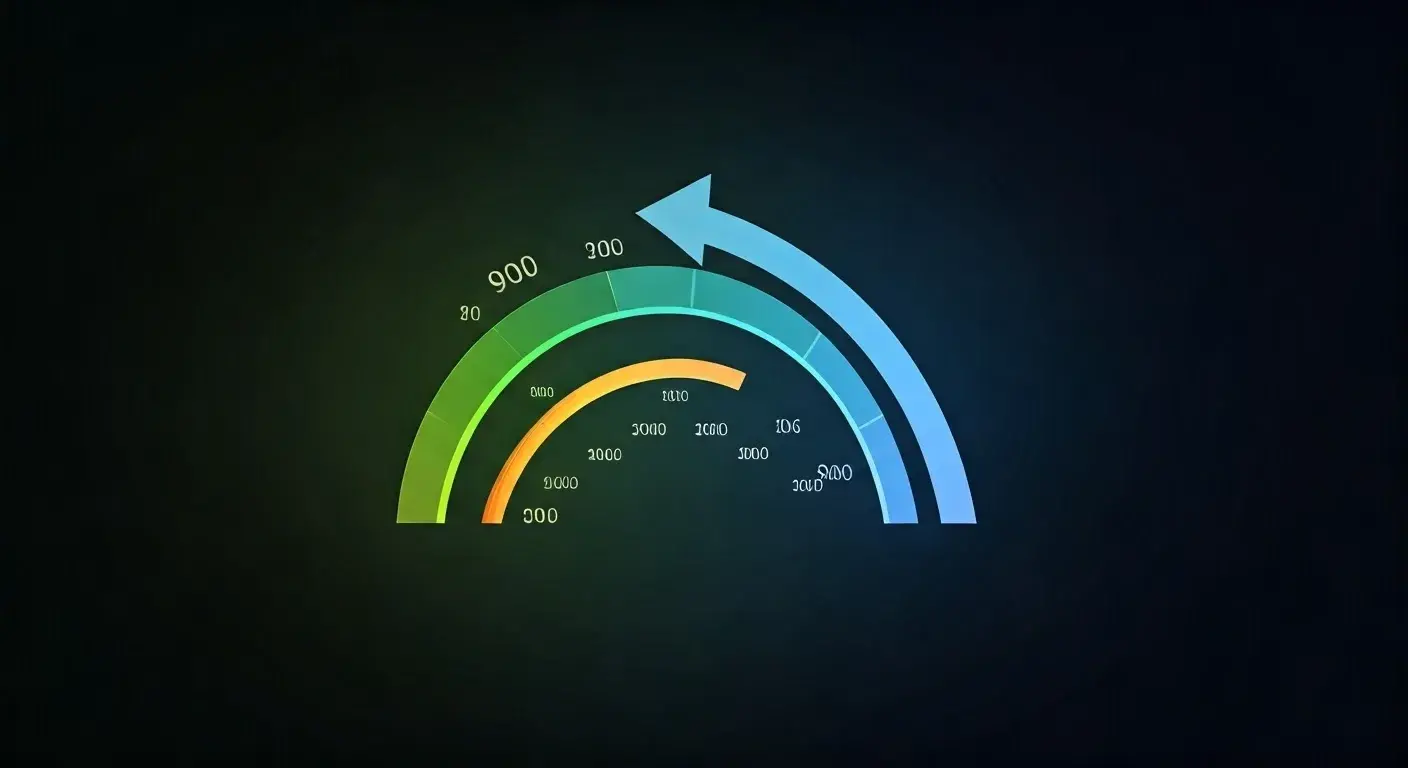-
Posted on: 22 Jul 2023

-
Improving your credit score is crucial for financial health, impacting loan approvals, interest rates, and even rental applications. This guide will dissect which actions demonstrably enhance your creditworthiness, focusing on proven strategies for 2025.
Understanding Your Credit Score
Before diving into improvement strategies, it's essential to grasp what a credit score represents and why it's so significant. A credit score is a three-digit number, typically ranging from 300 to 850, that lenders use to assess your creditworthiness. It's a snapshot of your financial behavior, predicting the likelihood that you'll repay borrowed money. In 2025, the average credit score in the United States hovers around 715, but this number can fluctuate based on various economic factors and demographic trends. A higher score signifies lower risk to lenders, translating into better financial opportunities.
Why Does Your Credit Score Matter in 2025?
The importance of a good credit score has only amplified in recent years. Beyond traditional loans like mortgages and auto financing, landlords often check credit scores before approving rental applications. Utility companies might require a deposit if your score is low, and even some employers may review credit reports for positions involving financial responsibility. In 2025, with rising interest rates and a competitive market, a strong credit score can be the difference between securing a loan at a favorable rate or being denied altogether. It’s a fundamental pillar of financial well-being.
The Key Components of a Credit Score
Credit scoring models, most notably FICO and VantageScore, evaluate several factors to generate your score. While the exact weighting can vary slightly between models and updates, the core components remain consistent. Understanding these components is the first step toward making informed decisions about your credit.
Payment History
This is the most critical factor, typically accounting for about 35% of your FICO score. It reflects whether you pay your bills on time. Late payments, defaults, and bankruptcies significantly damage this component.
Amounts Owed (Credit Utilization)
Accounting for roughly 30% of your FICO score, this measures how much of your available credit you are using. Keeping this ratio low is paramount.
Length of Credit History
This component, about 15% of your FICO score, considers how long your credit accounts have been open and the average age of your accounts. A longer history generally bodes well.
Credit Mix
Making up about 10% of your FICO score, this looks at the variety of credit you manage, such as credit cards, installment loans (like mortgages or auto loans), and other types of credit. A healthy mix can indicate responsible credit management.
New Credit
This accounts for the remaining 10% of your FICO score. It considers how many new accounts you've opened recently and how many credit inquiries you've had. Opening too many accounts in a short period can signal higher risk.
Payment History: The Undisputed King
When considering "Which of the following actions would improve a credit score?", the answer that consistently ranks highest in impact is maintaining a perfect payment history. Lenders want to see that you are reliable and can meet your financial obligations as agreed. This isn't just about credit cards; it encompasses all forms of credit, including loans, mortgages, and even some utility bills if they are reported to credit bureaus.
The Power of On-Time Payments
Every single payment you make on your credit accounts is reported to the major credit bureaus (Equifax, Experian, and TransUnion). When these payments are made on or before the due date, it signals to lenders that you are a responsible borrower. Consistently paying on time is the single most effective way to build and maintain a strong credit score. Even a single late payment, especially if it's 30 days or more past due, can have a significant negative impact that can take months, or even years, to recover from.
Strategies for Ensuring On-Time Payments
Given its importance, implementing robust strategies to ensure timely payments is a non-negotiable aspect of credit score improvement. Here are some effective methods:
- Set Up Automatic Payments: This is arguably the most effective strategy. Link your bank account to your credit card or loan accounts and set up automatic payments for at least the minimum amount due. This eliminates the risk of forgetting a due date. For those who prefer more control, setting up automatic payments for the minimum and then manually paying the rest before the due date can be a good compromise.
- Utilize Calendar Reminders: If automatic payments aren't feasible or preferred, set up recurring reminders on your phone, calendar, or even sticky notes. Schedule these reminders a few days before the due date to give yourself ample time to make the payment.
- Pay Bills Immediately Upon Receipt: Some individuals prefer to pay bills as soon as they receive them, rather than waiting for the due date. This proactive approach can prevent oversight and ensure payments are processed well in advance.
- Consolidate Due Dates: If you have multiple credit accounts with different due dates, try contacting your lenders to see if you can adjust your due dates to fall around the same time each month. This simplifies your payment schedule and reduces the chance of missing one.
- Keep Track of Payment Due Dates: Maintain a simple spreadsheet or use a budgeting app to track all your payment due dates. This central record can be invaluable for staying organized.
Dealing with Past Due Payments
If you have missed payments in the past, the best course of action is to address them immediately. If a payment is only slightly past due (e.g., 1-15 days), pay it as soon as possible. If it's already 30 days past due, the damage is likely already done, but paying it off will prevent further negative reporting. For significantly delinquent accounts, consider contacting the lender to discuss payment arrangements or a hardship plan. The sooner you resolve past due accounts, the sooner your credit score can begin to recover.
Managing Your Credit Utilization Ratio
The credit utilization ratio (CUR) is the second most significant factor influencing your credit score. It represents the amount of revolving credit you are using compared to your total available revolving credit. For instance, if you have a credit card with a $10,000 limit and a balance of $3,000, your CUR for that card is 30%. The total CUR is calculated by summing up all your credit card balances and dividing by the sum of all your credit card limits.
Why a Low Credit Utilization Ratio is Crucial
A high CUR signals to lenders that you might be overextended and relying heavily on credit, which increases the risk of default. Credit scoring models generally favor a CUR below 30%, with scores often improving significantly when the ratio is kept below 10%. In 2025, with the ongoing economic climate, lenders are particularly sensitive to high utilization. Keeping this ratio low demonstrates responsible credit management and financial discipline.
How to Calculate and Monitor Your CUR
Monitoring your CUR is straightforward. You can find your total credit card balances and limits on your credit card statements or by logging into your online credit card accounts. To calculate your overall CUR:
Formula: (Total Balances on Credit Cards / Total Credit Limits on Credit Cards) * 100 = Credit Utilization Ratio
For example, if you have two credit cards:
- Card A: $5,000 limit, $1,500 balance
- Card B: $10,000 limit, $2,000 balance
Total Balances = $1,500 + $2,000 = $3,500
Total Credit Limits = $5,000 + $10,000 = $15,000
CUR = ($3,500 / $15,000) * 100 = 23.3%
This 23.3% CUR would be considered healthy.
Actionable Steps to Lower Your Credit Utilization Ratio
Lowering your CUR is a direct path to improving your credit score. Here are the most effective actions:
- Pay Down Balances: The most straightforward method is to pay down your credit card balances. Focus on paying more than the minimum payment whenever possible. Prioritize paying down cards with the highest utilization first (the "avalanche method") or those with the highest interest rates to save money in the long run.
- Request a Credit Limit Increase: If you have a good payment history with a particular credit card issuer, you can request a credit limit increase. If approved, this will increase your total available credit, thereby lowering your CUR, assuming your balances remain the same. Be aware that some issuers may perform a hard inquiry for this, which can slightly impact your score temporarily.
- Avoid Maxing Out Credit Cards: Even if you can pay off the balance in full by the due date, carrying high balances throughout the month can be reported to credit bureaus before your statement closing date. Aim to keep your statement balances as low as possible.
- Spread Purchases Across Cards: If you have multiple credit cards, try to distribute your spending across them rather than concentrating it on one. This helps keep the utilization low on each individual card.
- Use Charge Cards Strategically: Charge cards, which require you to pay the balance in full each month, do not have a credit utilization ratio in the same way as traditional credit cards. Using them for larger purchases and paying them off can free up your revolving credit lines.
It's important to note that credit card companies report your balance to the credit bureaus on your statement closing date. Therefore, paying down your balance *before* your statement closing date is more effective for lowering your reported utilization than paying it down just before the payment due date.
The Length of Your Credit History Matters
The length of your credit history is another significant factor, contributing approximately 15% to your FICO score. This component considers two main aspects: the age of your oldest credit account and the average age of all your credit accounts. A longer credit history generally indicates more experience managing credit responsibly, making you a less risky borrower in the eyes of lenders.
Understanding the Impact of Account Age
Having older accounts in good standing demonstrates a long-term commitment to managing credit. The longer an account has been open and in good standing, the more positive it is for your credit score. Conversely, closing old accounts, especially those with no annual fee, can shorten your average account age and potentially lower your score. This is because closing an account effectively removes it from your credit history sooner, reducing the overall age of your credit profile.
Strategies for Lengthening Your Credit History
While you can't artificially age your credit history, several strategies can help you leverage this factor over time:
- Keep Old Accounts Open: As mentioned, resist the urge to close old credit card accounts, especially if they don't have an annual fee. Even if you don't use them frequently, keeping them open (perhaps with a small, recurring purchase that you pay off immediately) helps maintain your average account age.
- Become an Authorized User: If a trusted family member or friend with an excellent credit history is willing, they can add you as an authorized user to one of their older, well-managed credit cards. The positive payment history and age of that account can then appear on your credit report, potentially boosting your score. Ensure the primary account holder has a strong history, as their negative activity could also affect you.
- Open a New Account Strategically: When opening a new credit account, consider its potential impact on your average account age. While opening new accounts can temporarily lower your average age, it's a necessary step for building credit. Choose accounts that you intend to keep for the long term.
- Avoid Closing Accounts with Zero Balances: If an account has a zero balance and no annual fee, keeping it open is generally beneficial for your credit history length.
The Trade-off: New Credit vs. Length of History
It's important to balance the desire to lengthen your credit history with the impact of opening new accounts. While a long history is good, opening too many new accounts in a short period (which falls under the "New Credit" category) can negatively affect your score. The key is to open new accounts judiciously and only when you need them, ensuring they are managed responsibly.
Credit Mix and New Credit Considerations
The final two components of credit scoring models, credit mix and new credit, have a lesser but still notable impact on your overall score. Understanding how these factors work can help you make more informed decisions about your credit applications.
Credit Mix: Diversifying Your Credit Portfolio
Credit mix refers to the variety of credit accounts you have. This includes revolving credit (like credit cards) and installment loans (like mortgages, auto loans, and personal loans). Having a mix of different credit types can demonstrate your ability to manage various forms of credit responsibly. However, this factor is less critical than payment history or credit utilization. For example, having both a credit card and an auto loan is generally better than having only credit cards. However, you should never open a new type of credit solely to improve your credit mix if you don't genuinely need it.
New Credit: The Impact of Recent Activity
The "New Credit" category assesses how many new accounts you've opened recently and how many hard inquiries have been made on your credit report.
- Hard Inquiries: These occur when you apply for new credit (e.g., a credit card, loan, or mortgage). Each hard inquiry can slightly lower your score by a few points. Multiple hard inquiries in a short period can signal to lenders that you are seeking a lot of credit, which may indicate financial distress. However, inquiries made for "rate shopping" for mortgages, auto loans, or student loans within a specific timeframe (usually 14-45 days, depending on the scoring model) are often treated as a single inquiry.
- New Accounts: Opening several new credit accounts in a short span can also negatively impact your score, as it suggests increased credit risk.
Strategies for Managing New Credit:
- Apply for Credit Sparingly: Only apply for credit when you genuinely need it.
- Shop for Rates Within a Short Window: If you're looking for a mortgage or auto loan, do your rate shopping within a few weeks to minimize the impact of multiple inquiries.
- Avoid Opening Too Many Accounts at Once: Space out your credit applications over time.
Actions That Can Harm Your Credit Score
Understanding which actions improve your credit score is only half the battle. Equally important is knowing what to avoid. Certain financial behaviors can significantly damage your creditworthiness, leading to lower scores and making it harder to access credit in the future.
Common Pitfalls to Steer Clear Of
Here are some of the most common credit-damaging actions:
- Missing Payments: As emphasized, late payments are detrimental. Even one 30-day late payment can drop your score considerably.
- High Credit Utilization: Consistently carrying high balances on your credit cards signals risk. Aim to keep your utilization below 30%, and ideally below 10%.
- Closing Old Credit Cards: This can shorten your average credit history length and reduce your overall available credit, potentially increasing your utilization ratio.
- Applying for Too Much Credit at Once: Multiple hard inquiries and new accounts in a short period can signal financial distress.
- Defaulting on Loans or Credit Cards: This is one of the most severe negative marks, leading to significant score drops and long-lasting damage.
- Having Accounts Sent to Collections: Unpaid debts that go to collections will severely impact your credit score.
- Filing for Bankruptcy: A bankruptcy filing remains on your credit report for seven to ten years and has a profound negative effect on your score.
- Co-signing Loans You Can't Afford: If the primary borrower defaults, you become responsible for the debt, and their missed payments will appear on your credit report.
- Ignoring Credit Report Errors: Incorrect information on your credit report can negatively affect your score. It's crucial to review your reports regularly and dispute any inaccuracies.
The Long-Term Consequences of Negative Marks
Negative marks on your credit report, such as late payments, collections, or defaults, can remain for up to seven years (bankruptcies for ten years). The longer these marks stay on your report, the less impact they tend to have, but they can still prevent you from obtaining favorable credit terms for years. In 2025, with lenders becoming more cautious, these negative marks can be even more prohibitive.
Putting It All Together: Actionable Strategies
Now that we've explored the various components of credit scoring and common pitfalls, let's consolidate the most effective actions that directly answer "Which of the following actions would improve a credit score?"
The Top Tier Actions for Credit Score Improvement
These are the actions that will yield the most significant and rapid improvements to your credit score:
- Pay All Bills on Time, Every Time: This is the bedrock of a good credit score. Set up automatic payments, use reminders, and prioritize on-time payments for all your credit obligations.
- Keep Credit Card Balances Low: Aim to keep your credit utilization ratio below 30%, and ideally below 10%. Pay down balances aggressively, and consider requesting credit limit increases if appropriate.
- Don't Close Old, Unused Credit Cards (Especially Those with No Annual Fee): Maintaining a longer credit history is beneficial. Keep these accounts open to preserve your average account age and available credit.
- Dispute Errors on Your Credit Report: Regularly review your credit reports from Equifax, Experian, and TransUnion. If you find any inaccuracies, dispute them immediately with the credit bureau and the creditor. This can sometimes lead to a quick score increase if errors are removed.
Secondary Strategies for Gradual Improvement
While the above actions are paramount, these strategies can also contribute to a stronger credit profile over time:
- Become an Authorized User on a Well-Managed Account: If you have a trusted individual with excellent credit, being added as an authorized user can lend their positive history to your report.
- Consider a Secured Credit Card or Credit-Builder Loan: If you have a very low credit score or no credit history, these tools can help you build or rebuild credit. A secured credit card requires a cash deposit that becomes your credit limit, and a credit-builder loan holds the loan amount in an account until you pay it off.
- Maintain a Healthy Credit Mix (Naturally): As you manage your credit over time, a natural mix of credit types will develop. Avoid opening new accounts solely for the purpose of credit mix.
- Be Patient: Credit score improvement is a marathon, not a sprint. Consistent, responsible financial behavior over time is key.
Illustrative Scenarios (2025 Context)
Let's look at a couple of hypothetical scenarios to illustrate the impact of these actions:
Scenario A: Sarah's Credit Score Jump
Sarah, a 28-year-old marketing professional, had a credit score of 620 due to a few late payments in her early 20s and high credit card balances. She decided to focus on improving her score to buy a car in 2025.
- Action 1: She set up automatic payments for all her bills, ensuring no more late payments.
- Action 2: She paid down her credit card balances from $8,000 (on a $10,000 total limit) to $3,000, bringing her utilization from 80% to 30%.
- Action 3: She kept her oldest credit card, opened 8 years ago, open.
Scenario B: David's Steady Improvement
David, a 35-year-old software engineer, had a decent credit score of 700 but wanted to reach the excellent tier (740+) for a better mortgage rate in 2025.
- Action 1: He already paid bills on time.
- Action 2: He aimed to lower his utilization from 25% to below 10%. He paid down his balances from $2,500 (on a $10,000 total limit) to $900.
- Action 3: He reviewed his credit report and found an old, incorrect inquiry that he successfully disputed and had removed.
Your Path to a Better Credit Score
In summary, the most impactful actions to improve your credit score revolve around consistent, responsible financial behavior. Prioritizing on-time payments is paramount, as it forms the largest component of your creditworthiness. Following closely is the management of your credit utilization ratio; keeping balances low relative to your credit limits demonstrates financial discipline and significantly boosts your score. Furthermore, maintaining a longer credit history by keeping older accounts open and avoiding unnecessary closures contributes positively over time.
Actions to avoid include missing payments, carrying high balances, and opening too many new accounts simultaneously. Regularly reviewing your credit reports for errors and disputing any inaccuracies is also a critical, often overlooked, step. For those starting out or rebuilding, secured credit cards and credit-builder loans offer viable pathways to establishing a positive credit history. Remember that credit score improvement is a journey that requires patience and consistent effort. By focusing on these proven strategies, you can effectively enhance your creditworthiness and unlock better financial opportunities in 2025 and beyond.
Faq
FAQ 1: How Long Does It Take to Improve a Credit Score?
Improving your credit score is a gradual process that depends on various factors, including the current state of your credit and the actions you take. In some cases, noticeable improvements can be seen within a few months, while significant changes may take a year or more.
FAQ 2: Can Closing Unused Credit Cards Improve My Credit Score?
Closing unused credit cards can harm your credit score, especially if they have a long history of on-time payments. The age of your credit accounts contributes to your credit score, so keeping them open can be beneficial.
FAQ 3: Will Settling Debts Help Improve My Credit Score?
Settling debts may provide some relief from financial burdens, but it may not have a substantial positive impact on your credit score. It's better to focus on making timely payments and reducing credit card balances.
FAQ 4: Can I Improve My Credit Score on My Own?
Absolutely! Improving your credit score is a proactive process that anyone can undertake. By adopting responsible credit management practices and being consistent, you can see significant improvements over time.
FAQ 5: How Often Should I Check My Credit Score?
It's advisable to check your credit score at least once a year. You can obtain a free credit report from each of the major credit bureaus once every 12 months.
FAQ 6: Are Credit Repair Companies Effective?
Credit repair companies may promise quick fixes, but they cannot achieve anything that you cannot do on your own. Some reputable companies can help with credit disputes, but be cautious of scams.











